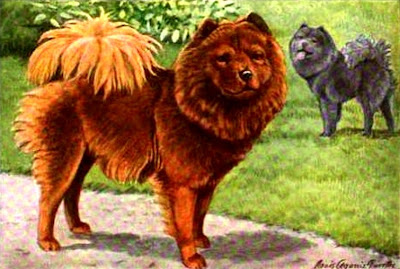 | Though there are two types of Chow in China, whence we got it, the smooth type has never been popular here nor in England, and may be ignored in this connection. |
Perhaps no dog has more individuality, nor knows his own mind better than the Chow. He is frisky, playful, intelligent, and willing to obey his master implicitly; the rest of earth's population has no interest for him whatever. Those the artist has known were entirely tolerant of his presence, and even his caresses, in their own home or when their master was with them elsewhere. Off the porch or on the street they will not so much as notice a stranger, except that it is impossible to put a hand on them or elicit a glimmer of recognition. Of all dogs they are the most consistently a "one-man" type.
The Chow has several real peculiarities, among which the most pronounced is the purplish black interior of the mouth, including the tongue. He is a very cobby dog, standing on four exceedingly straight legs. He is straightcr in the stifle than any other dog. The muzzle should be short, the head square and massive, with a sort of scowl or frown that is helped by the widely set eyes.
The fur is very dense and deep, with a separate underfur like that of the Eskimo or other Arctic dogs, from which the Chow is supposedly derived. It also has the wide chops, small eye, and curly tail of his congeners.
The feet are small and catlike and the pointed ears are held upright. The neck all round has very deep fur, forming a sort of mane or ruff. All in all, he is about the most distinct type of dog to be seen. He has plenty of courage, though he is generally prudent and keeps out of trouble. With those he knows he is extremely
patient, being in this respect a fine dog to be among children.
The Chow is a common dog in China, but in this country he is regarded as an aristocrat, which is not unreasonable considering his proud bearing and ancient lineage.
Whether black, red, yellow, blue, or white, he is a dog of striking appearance and reminds one of an animated Chinese carving.
From The Book of Dogs: An Intimate Study of Mankind's Best Friend By National Geographic Society (U.S.), Louis Agassiz Fuertes, Ernest Harold Baynes Published 1919. 109 pages Original from Harvard University.
This image (or other media file) is in the public domain because its copyright has expired.
This applies to the United States, where Works published prior to 1978 were copyright protected for a maximum of 75 years.
See Circular 1 "COPYRIGHT BASICS" from the U.S. Copyright Office. Works published before 1923 are now in the public domain In the United States,
This inage is also in the public domain in countries that figure copyright from the date of death of the artist (post mortem auctoris in thi case Louis Agassiz Fuertes (1874 – 1927) and that most commonly runs for a period of 50 to 70 years from that date. If your use will be outside the United States please check your local law.
Tags: Public Domain Clip Art and clip art or public domain and Chow













No comments:
Post a Comment